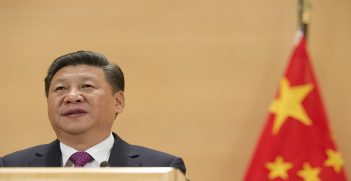The Sustainability of China’s High-Performance Computing Agenda

As world leaders gather to discuss climate change in Poland, the need to reduce emissions may hamper China’s development of big data and quantum processing.
China’s pursuit of big data and quantum processing is progressing at an accelerated pace. President Xi Jinping’s vision of integrated internet, big data and artificial intelligence with the real-world economy—as per his 19th Party Congress report—is reliant on growth in Chinese data centres. Today, the United States hosts over 17 million square meters of data centres, while China hosts approximately 2 million. However, the number of internet users in China is three times greater than the US, and the compound annual growth rate of the data centre industry in China is estimated at 15 per cent from 2016-2020.
Along with investments in big data, analytics and processing, China is pursuing megaprojects for quantum communications and computing. These will expand China’s national quantum communications infrastructure; develop a general quantum computer prototype; establish a practical quantum simulator; and fund the National Laboratory for Quantum Information Sciences. Referencing consistent advances in basic research, some analysts contend that China is challenging and perhaps surpassing American superiority in quantum research.
Big data and quantum computing
Today phones, watches, TVs, cars and even lightbulbs leave electronic footprints, and most people don’t realise how their online activities contribute to a digital gold mine. Both commercial and military actors gain intelligence by extracting meaning from dynamic and complex datasets, which is fuelling demand for high performance computing and advanced analytics capabilities.
Within the last twelve months, China’s “big three”—Alibaba, Baidu and Tencent—have invested heavily in quantum computing to support national and business objectives in big data processing. In February, Alibaba Cloud and the Chinese Academy of Sciences jointly launched an 11-qubit quantum computing service through the Quantum Computing Cloud Platform. In March, Baidu announced the appointment of University of Technology Sydney Professor Runyao Duan as the inaugural director of its quantum computing institute. And in May, Tencent signed a Memorandum of Understanding with the UK Government’s Department for International Trade—leveraging a longstanding relationship with the University of Oxford on quantum computing.
Elsa Kania from the Center for a New American Security’s questions the military return on investment for quantum megaprojects, among other gambles China has made on disruptive technologies. Though China’s military is a key stakeholder in technological advancement, its big bets at the intersection of military and commercial interests show the greatest potential. The use of quantum algorithms for data analysis is one such example: a recent MIT/Waterloo/USC study found quantum computers well-suited to topological analysis, a resource-heavy process used to highlight significant features of complex datasets. Topological analysis of a dataset with 300 points would require 2300 of today’s processing units, or just 300 quantum bits, according to the authors. This technology is a long way off, but its realisation would revolutionise the analysis of social media, economic and financial information. Social security infrastructure and a national surveillance network are other potential applications that spring to mind.
Power demands
In 2015, the information and communication technology industry’s power demands were predicted to increase from 200-300TWh per annum to 1,200-3,000TWh per annum by 2025. Devices connected to the Internet of Things (IoT) are projected to rise from 8.4 billion to 20.4 billion in 2020. These trends are intertwined: information generated by each IoT-enabled device feeds back into a data centre, where it is stored, processed and analysed. The business of building data centres alone grosses around $20 billion per annum worldwide. When completed, these centres become part of a power-hungry network that emits as much carbon dioxide gas (CO2) as the global airline industry. These environmental and economic costs will increase in the immediate future. While quantum processing can be incredibly power-efficient—it takes a fraction of a microwatt to power D-Wave’s 2X quantum processor compared to 10 watts for a traditional high-end computing core—D-Wave’s setup demands 28MW to keep niobium superconductors chilled at -273 degrees Celsius, more than offsetting gains in energy and processing efficiency. While quantum computing at room temperature is becoming more accessible, significant advances in silicon-based quantum processors mean that the trend of using atomically heavy metals at cryogenic temperatures is likely to continue.
This might not be a problem for China, as the world’s largest electricity producer, but it is also the largest emitter of fossil fuel CO2 emissions. Over half the country’s electricity comes from coal, and coal-powered electricity generation is expected to increase from 960GW in 2016 to 1300GW in 2020. As China grapples with the trade-off between cost and processing power, we can assume it will employ reliable and cheap coal-generated electricity to power its first generation of quantum computers.
Takeaway
The development of artificial intelligence and quantum computing capabilities will increase global demand for data. The necessary data centres will increase CO2 emissions and demand for electricity. In China, this remains predominantly coal-generated.
This means that many of China’s technological investments are gambles against the global movement to limit climate change. Reducing its coal-generated electricity consumption and overall CO2 emissions, would decrease the domestic supply of electricity and reduce growth in data centres, limiting the development of new technology.
William Rooks is a Master’s candidate at the University of New South Wales. He holds a Bachelor of Arts with majors in Political Science and International Relations from The Australian National University.
This article is published under a Creative Commons Licence and may be republished with attribution.





